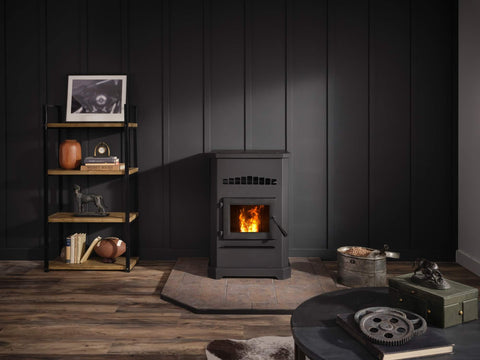The new Biomass Tax Credit was approved as part of the Inflation Reduction Act qualifying certain highly-efficient biomass appliances for a tax credit until 2032. For those looking to add or replace a biomass stove, this tax credit is one more reason to transition to a more efficient and sustainable heating option for their home.
In this blog, we will cover the parameters of this new tax credit, how to heat sustainably, plus how to choose a qualifying biomass stove.
What is the 2023 Biomass Tax Credit?
For those looking to upgrade their current stove or switch from another heating source, the 2023 biomass tax credit is just one more incentive (among a long list of many other reasons!) to purchase a new biomass stove.
During the period beginning January 1, 2023 through December 31, 2032, taxpayers who install qualifying wood and pellet stoves can receive a 30% tax credit up to $2,000 annually, based on the full cost (purchase and installation) of the unit.
What Stoves are Eligible for a Federal Tax Credit?
Eligible stoves include those with a “thermal efficiency of at least 75% per the higher heating value (HHV) of the fuel” (Hearth, Patio, and Barbeque Association.) For those concerned about their carbon footprint, qualifying wood and pellet stoves are an alternative to other heating methods as they produce very low emissions into our atmosphere.
For a complete list of qualified appliances, check out the products over 75% higher heating value efficiency located in the EPA’s database.
What is Biomass Fuel and What Makes it Sustainable?
Biomass is a renewable organic material derived from natural resources such as wood, agricultural crops, and biogenic materials. For heating purposes, biomass stoves generally use wood and wood byproducts such as pellets. Biomass fuels are converted into energy through direct combustion, thus emitting heat to the surrounding area.
Pellets are a great option for those looking for a fuel with a very small carbon footprint. “Wood pellet manufacturers extend the value and lifespan of these materials by converting them into a high-quality engineered heating product which displaces the use of fossil-derived heating oil and propane as well as their carbon consequences,” according to the Pellet Fuels Institute.
Use of biomass fuels are increasing in developed countries as mindfulness of each households’ carbon footprint becomes more top-of-mind. For those ready to make small changes with a big collective impact, wood and pellet stoves are great options.
How to Claim the Biomass Stove Federal Tax Credit
In order to receive your tax credit, you will need to submit all documents related to the purchase and installation of your stove, plus the manufacturer’s federal tax credit certificate. This paperwork will serve as proof of the stove’s eligibility, purchase year, stove and installation cost, and the year it was installed into your home.
The federal tax credit is applied by the year the stove was installed into your home. Keep in mind that if you buy a wood or pellet stove in 2023 but have it installed in 2024, your tax credit will be applied to your 2024 tax return. For homeowners looking to add more than one qualified stove to their home, we recommend spreading out the purchases by separate calendar years to fully capitalize on the tax benefits offered through this credit.
How to Access the Manufacturer Federal Tax Credit Certificate
Accessing your manufacturer's federal tax certificate is key to ensuring the biomass tax credit is deducted from your annual taxes. Each manufacturer should supply a certificate, which normally can be found on their website.
If buying a brand other than Quadra-Fire, Harman, or Vermont Castings, be sure to double-check that the certificate includes the necessary information:
- Manufacturer’s name and address
- The class of qualified energy
- Stove’s make and model
- Proof of eligibility statement
- Manufacturer’s signature
If you have purchased a Quadra-Fire stove, you can find a link to download the certificate here. For Harman’s certificate, click here. For Vermont Castings' certificate, click here.
How to Choose a Tax Credit-Qualifying Stove
Choosing the right stove for you comes down to your needs, lifestyle, and priorities. By keeping the following considerations in mind, you are bound to find the right stove for your home.
Considerations to keep in mind:
- Cost
- Fuel
- Ease of use
- Size
- Product material
- Maintenance
- Heat output
- Brand
There are a plethora of stoves on the market, which means the perfect stove for your lifestyle and needs is out there — it just takes a little research and consideration to ensure a stove will be a good fit for your home.
Next Steps

Ready to make your stove dreams a reality? We are here to help! Forge & Flame offers numerous eligible pellet and wood appliances in different sizes, materials, heat outputs, and more to ensure you find the perfect biomass stove for your home.
If you have any further questions, we recommend visiting a certified dealer, who can guide you to the perfect stove for your needs.






